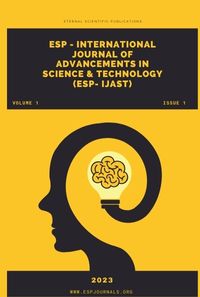ESP International Journal of Advancements in Science & Technology [ESP-IJAST]
Citation :
Jawahar Thangavelu, 2024. "Artificial Intelligence in Engineering Design: Enhancing Creativity and Efficiency" ESP International Journal of Advancements in Science & Technology (ESP-IJAST) Volume 2, Issue 3: 29-39.
Abstract :
Today, engineering design has been enhanced significantly by the integration of Artificial Intelligence (AI). By simplifying routine work related to parametric design and performance optimization, AI enables engineers to work on more advanced tasks. The fast processing of large amounts of data makes it possible for designers to consider a great number of design solutions within a considerably shorter time than it would take with traditional approaches. This has mainly resulted in shorter design cycle times as well as reductions in the amounts of material used and total costs of a project. Techniques such as generative design and machine learning have yielded highly satisfying results in terms of structure, pattern recognition and results prediction, offering solutions that were impossible by normal means.
This paper presents a detailed review of the modern AI methods and tools that expedite engineering design in several sectors, including aerospace and automotive, as well as the civil engineering industry. We discuss the state of the art of AI for design, based on the application of AI in structural optimization, CFD, and FEA. This paper shows virtually and practically how artificial intelligence is improving design applications, precision, and creativity in engineering designs through a review of literature and experimental case studies. Furthermore, the paper outlines some potentially serious issues related to AI implementation, such as the inadequate integration of data sources, the understanding of multilayer structures of most modern AI models, and human supervision of the AI results. Last, we discuss future research implications for overcoming these challenges in an effort to enhance the practicality and utility of AI for design practice.
References :
[1] Raz, A. K., Blasch, E. P., Guariniello, C., & Mian, Z. T. (2021). An overview of systems engineering challenges for designing AI-enabled aerospace systems. In AIAA Scitech 2021 Forum (p. 0564).
[2] Williams, C. (1986). Expert systems, knowledge engineering, and AI tools-an overview. IEEE Intelligent Systems, 1(04), 66-70.
[3] Dias, W. P. S. (2002). Reflective practice, artificial intelligence, and engineering design: Common trends and interrelationships. AI EDAM, 16(4), 261-271.
[4] Smithers, T., Conkie, A., Doheny, J., Logan, B., Millington, K., & Tang, M. X. (1990). Design as intelligent behaviour: an AI in the design research programme. Artificial Intelligence in Engineering, 5(2), 78-109.
[5] Yüksel, N., Börklü, H. R., Sezer, H. K., & Canyurt, O. E. (2023). Review of artificial intelligence applications in engineering design perspective. Engineering Applications of Artificial Intelligence, 118, 105697.
[6] La Rocca, G. (2012). Knowledge based engineering: Between AI and CAD. Review of a language based technology to support engineering design. Advanced engineering informatics, 26(2), 159-179.
[7] Nadkarni, P. M., Ohno-Machado, L., & Chapman, W. W. (2011). Natural language processing: an introduction. Journal of the American Medical Informatics Association, 18(5), 544-551.
[8] Herdrix, G. G. (1977, August). Human engineering FCR applied natural language processing. In Proc. 5th Int'l Joint Conf. Artificial Intelligence (pp. 183-191).
[9] De Silva, D., & Alahakoon, D. (2022). An artificial intelligence life cycle: From conception to production. Patterns, 3(6).
[10] Blanchard, B. S. (2004). System engineering management. John Wiley & Sons.
[11] Ahmad, K., Abdelrazek, M., Arora, C., Bano, M., & Grundy, J. (2023). Requirements engineering for artificial intelligence systems: A systematic mapping study. Information and Software Technology, 158, 107176.
[12] Kearney, P. (2002). Integrating AI planning techniques with workflow management system. Knowledge-Based Systems, 15(5-6), 285-291.
[13] Sanodia, G. (2024). Leverage AI to Improve Cloud Transformation. Journal of Scientific and Engineering Research, 11(8), 95-105. Geetesh Sanodia
[14] Fischer, L., Ehrlinger, L., Geist, V., Ramler, R., Sobiezky, F., Zellinger, W., ... & Moser, B. (2020). Ai system engineering—key challenges and lessons learned. Machine Learning and Knowledge Extraction, 3(1), 56-83.
[15] Gu, H., Liang, Y., Xu, Y., Williams, C. K., Magaki, S., Khanlou, N., ... & Chen, X. A. (2023). Improving workflow integration with XPath: design and evaluation of a human-AI diagnosis system in pathology. ACM Transactions on Computer-Human Interaction, 30(2), 1-37.
[16] Panwar, V., Vandrangi, S. K., & Emani, S. (2020). Artificial intelligence-based computational fluid dynamics approaches. In Hybrid Computational Intelligence (pp. 173-190). Academic Press.
[17] Mazuroski, W., Berger, J., Oliveira, R. C., & Mendes, N. (2018). An artificial intelligence-based method to efficiently bring CFD to building simulation. Journal of Building Performance Simulation, 11(5), 588-603.
[18] Zhang, Y., Tiňo, P., Leonardis, A., & Tang, K. (2021). A survey on neural network interpretability. IEEE Transactions on Emerging Topics in Computational Intelligence, 5(5), 726-742.
[19] He, C., Ma, M., & Wang, P. (2020). Extract interpretability-accuracy balanced rules from artificial neural networks: A review. Neurocomputing, 387, 346-358.
[20] Bharatbhai Pravinbhai Navadiya. (2024). A Survey on Deep Neural Network (DNN) Based Dynamic Modelling Methods for Ac Power Electronic Systems. International Journal on Recent and Innovation Trends in Computing and Communication, 12(2), 735–743. IJRITCC
[21] Heyn, H. M., Knauss, E., Muhammad, A. P., Eriksson, O., Linder, J., Subbiah, P., & Tungal, S. (2021, May). Requirement engineering challenges for ai-intense systems development. In 2021 IEEE/ACM 1st Workshop on AI Engineering-Software Engineering for AI (WAIN) (pp. 89-96). IEEE.
Keywords :
Artificial Intelligence (AI), Engineering Design, Creativity, Efficiency, Machine Learning, Generative Design, Optimization Algorithms, Collaborative Design, Automation, Predictive Analytics, Design Thinking, Innovation.


 : 10.56472/25839233/IJAST-V2I3P104
: 10.56472/25839233/IJAST-V2I3P104